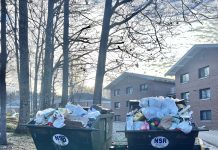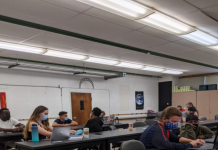Professor Mark Mitch is one among many faculty and staff who have a small, blue recycling bin in their office, with a tinier black bin for trash. The recycling bin is part of the Tiny Trash program, which promotes waste awareness and environmental stewardship. However, every morning the recycling and waste bins are collected, and if there is contamination within the recycling bin, it may be regarded as waste and later disposed into the garbage dumpster.
After speaking with Professor Mitch, it became evident that the issue with recycling is much larger than a small, blue recycling bin.
There are students and faculty on the NEC campus who recognize the environment is suffering and recycle. However, it can be frustrating to watch these efforts collectively being tossed in the back of a garbage truck.
Two dumpsters are located outside of student dorms, one for recycling and one for garbage. As the amount of students coming to NEC increases, the amount of garbage produced by students inevitably increases too. The garbage dumpster is emptied twice a week by Naughton and Son, but it ends up overflowing to the recycling. The limited space for garbage disposal leads students to resort to tossing their garbage into the big, green recycling dumpster, creating high amounts of cross contamination. Recyclable material such as some plastics, cardboard, paper and glass become coated with food and waste that is not recyclable.
Contamination puts pressure on Naughton and Son to sift through the garbage dumpster to clean and properly sort any salvaged recyclable material. However, the company does not sort through contaminated recycling dumpsters. Ultimately, this leads to everything being collectively piled into the back of a garbage truck. The recyclables and garbage are brought to a new home and it is not a landfill, but an incinerator in Penacook, New Hampshire.
While it may be comforting to know improperly disposed plastic is not going to be floating in the ocean, decomposing for hundreds of years or being ingested by an unsuspecting marine organism, incineration it is just as bad. The incinerator does not make the recyclables and garbage go away; there is no away. The plastic Starbucks cup someone used this morning and consciously tossed in the garbage will end up contributing to greenhouse gasses.
Some emissions produced by the incinerator are controlled, meaning metals, mercury and particulate matter are not going into the atmosphere. Yet, Carbon Dioxide (CO2) is still being emitted into Earth’s atmosphere, and CO2 traps heat, with 25% of CO2 absorbed by the ocean. The ocean is absorbing more CO2 than it can release, leading to ocean acidification. Ocean acidification is when the acidity of seawater rises which can have detrimental effects to marine species.
Of course, there are students, faculty, and staff that do not recycle at all. Reasons can range from community-members being unaware of what is and is not recyclable to not caring. But a lack of awareness or conscious effort is causing damage far beyond the college campus.
Healing the broken recycling system begins with outreach. Efforts to capture attention and cultivate change starts by ensuring that people are aware that recycling is an option and how to do it properly.
NEC follows single stream recycling, meaning community-members do not need to separate paper from plastic or plastic from glass. The recyclable materials can all go into one recycling bin and then into a recycling dumpster. This keeps it simple for students, staff, and faculty.
Educating one another on the importance of recycling and how to do it correctly is the most important element in improving recycling at NEC.
Put value back into the small, blue bin.



















